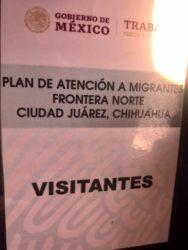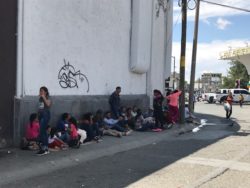I got back late Saturday night and, I have to say, I’m even more frustrated, disheartened and angry than I was before I went. As I learned instantly from organizations working at the border that first day: with the restrictive government policies in place right now, there’s not much we can do legally (or illegally).
 I was under the impression that I’d be working at the shelters and detention centers, doing anything that needed to be done—working with these people who are desperately trying to claim Political Asylum ; doing anything to help them wile away the hours and days they spend there, possibly, teaching them some English or geography or anything else that interests them. I was even ready to help with folding towels or serving meals. However the organization I was working with had the volunteers (there were 6 of us that week) spending all day interviewing as many immigrants who walked into CAIM (Mexico’s Center for Comprehensive Migrant Services). Ironically, CAIM was situated in view of the International Bridge where they had been pushed back across into Juarez by Border Patrol due to the administration’s new MPP (Migrant Protection Protocols) more properly dubbed the “Remain in Mexico” policy.
I was under the impression that I’d be working at the shelters and detention centers, doing anything that needed to be done—working with these people who are desperately trying to claim Political Asylum ; doing anything to help them wile away the hours and days they spend there, possibly, teaching them some English or geography or anything else that interests them. I was even ready to help with folding towels or serving meals. However the organization I was working with had the volunteers (there were 6 of us that week) spending all day interviewing as many immigrants who walked into CAIM (Mexico’s Center for Comprehensive Migrant Services). Ironically, CAIM was situated in view of the International Bridge where they had been pushed back across into Juarez by Border Patrol due to the administration’s new MPP (Migrant Protection Protocols) more properly dubbed the “Remain in Mexico” policy.
All of Juarez was in chaos—religious and non-religious organizations, the Border Patrol, the Homeland Security people, the Mexicans—everyone trying to adapt to the almost daily changing policies from Washington DC.
 We had been sent to screen the political asylum seekers for the pro bono attorneys who were also there waiting to help them if they had a “case” of political asylum, defined by the new policies. However, by this time, no newIy arrived people could ask for political asylum because they must step one foot in the U.S. in order to do so. By former immigration policies, many of them would have had a case for asylum but no more however, our organization as well as others could not adapt that quickly to change to this new protocol.
We had been sent to screen the political asylum seekers for the pro bono attorneys who were also there waiting to help them if they had a “case” of political asylum, defined by the new policies. However, by this time, no newIy arrived people could ask for political asylum because they must step one foot in the U.S. in order to do so. By former immigration policies, many of them would have had a case for asylum but no more however, our organization as well as others could not adapt that quickly to change to this new protocol.
For those who had been pushed back across the border but had been able to step one foot in the U.S., they were waiting everywhere in Juarez (one of the most dangerous cities in the world); on sidewalks, on the grass, possibly at a shelter which the Mexican government had been able to hurriedly set up (but only cycle through there for 15 days), in shelters set up by people of Juarez themselves. They were given a number which corresponded to how many people were ahead of them in the line to even be able to plead their case before an immigration judge set up on TV in a tent. When I got there, the number was more than 12,000 but with U.S. Customs and Border Protection in El Paso calling up only about three asylum seekers a day from the list, which they gently call “metering”, the list, which has gained mythic status, has now grown to about 20,000. The day I first crossed the border, immigrants were left sleeping near where numbers were called on the Mexican side for fear that they would lose their place in line. They were all stuck in limbo.
Even having to listen to their horror stories of what they’ve endured would have been alright if we knew we were really doing something positive. As it was, we were the ones responsible for informing each of these desperate people that, even though we’ve listened to them and filled out this 3 page form in English to give to the attorneys, their chance of actually receiving asylum right now from the U.S. courts is almost impossible—less than one percent we were informed by Las Americas Immigrant Advocacy Center in El Paso. It was unfortunate, also, that most of these shattered people had their hopes up that the interview with us was the first step to their eventually receiving asylum. In reality, of course, it wasn’t.
 Even during the one day we spent at one of the shelters in the desert outside Juarez, we were responsible for conducting these interviews rather than doing something concrete for the people themselves. We did have about a half hour to have fun with the children who all wanted to learn English, play soccer, or comb my hair!
Even during the one day we spent at one of the shelters in the desert outside Juarez, we were responsible for conducting these interviews rather than doing something concrete for the people themselves. We did have about a half hour to have fun with the children who all wanted to learn English, play soccer, or comb my hair!
In this shelter, the people were all Central Americans while the people at the Centro de Atención a Migrantes (CAIM) in downtown Juarez were a mix of Central Americans, Cubans and any other migrant trying to better themselves in the United States. Many have been waiting months in Juárez for their turn to cross the international bridge. These asylum seekers don’t even have the possibility of returning to their violent situation at home. They have no money to go back, even if they wanted to. We suggested to them that maybe they should apply for asylum in Mexico which would be easier. Every one of them was horrified and told us that they were almost as afraid to stay in Mexico even if they did apply for asylum there. It would be just as violent as situation as they escaped from. And, those who DID get a hearing were told by the judge it was important that they attend “another hearing sometime in the future” or they’d face a removal order in absentia, which would prevent them from re-entering the U.S. for 10 years.
 We, on the other hand, crossed the Bridge every day on foot and were allowed into Mexico with no one stopping us. When we returned at the end of the day to El Paso, however, we had to stand in a “Disney line” in Immigration, then put our bags through one of those x-ray scanners. Yet, after all of that ‘indignity’, we walked into the U.S. For some reason, the U.S. Immigration officer always asked me (not the others) what I was doing in Juarez, to which I always replied “sightseeing”. Maybe it was because I had a Russian Visa in my passport as well as a stamp in Arabic or maybe because he wanted me to understand that he knew exactly what I was doing.
We, on the other hand, crossed the Bridge every day on foot and were allowed into Mexico with no one stopping us. When we returned at the end of the day to El Paso, however, we had to stand in a “Disney line” in Immigration, then put our bags through one of those x-ray scanners. Yet, after all of that ‘indignity’, we walked into the U.S. For some reason, the U.S. Immigration officer always asked me (not the others) what I was doing in Juarez, to which I always replied “sightseeing”. Maybe it was because I had a Russian Visa in my passport as well as a stamp in Arabic or maybe because he wanted me to understand that he knew exactly what I was doing.
To sum up my week, I’d have to say that I was able to bear witness to what was happening but was pretty much helpless otherwise.
I wish I could feel better about doing something but our hands were tied…and the chaos only continues to get worse.
“Human suffering anywhere concerns men and women everywhere.”
~~Elie Wiesel
- At the El Paso/Juarez Border – by Dr. Barbara Weitz - January 2, 2020

